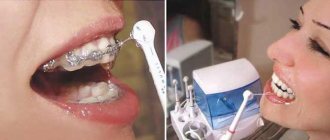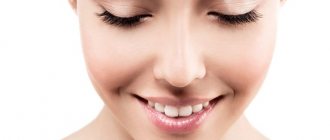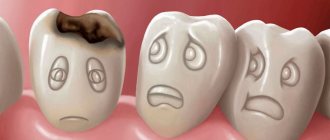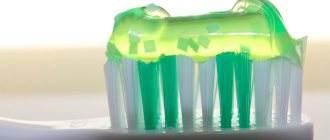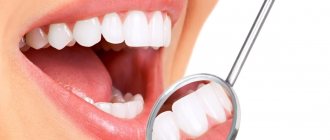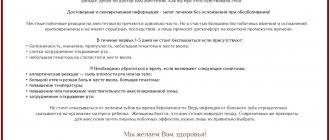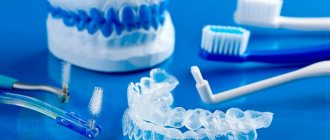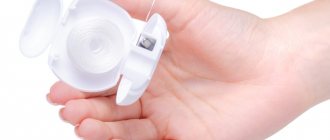- How is ultrasonic teeth cleaning performed?
- Pros and cons of ultrasonic cleaning
- Contraindications for ultrasonic cleaning
- Features of the Air Flow procedure
- Pros and cons of Air Flow
- Air Flow contraindications
- Comparative characteristics
As part of professional dental hygiene, patients are offered various methods of teeth cleaning in a dental clinic. The most popular are Air Flow and ultrasound. It is important to understand the differences between them in order to choose the option that is optimal in terms of efficiency and cost.
How is ultrasonic teeth cleaning performed?
If we are talking about the need to remove significant dental plaque, the doctor may decide to use a safe local anesthetic; as a rule, a special gel or solution is used that is sprayed onto the gum tissue.- Ultrasonic waves are sent through the attachment to the surface of the teeth, which create a vibration effect and crush stones into small particles.
- At the grinding stage, the remaining stones are removed using a paste and the enamel surface is polished.
- Optionally, the surface of the teeth is fluoridated to create a protective effect.
Teeth brushing using Air flow technology
Using this method, you can clean your teeth from soft and pigmented plaque.
The procedure is carried out using a device that supplies an air-water jet with the addition of a special powder. All this happens under pressure and destroys dental plaque well in hard-to-reach places. Water washes the surface of the tooth, softening the effect of the abrasive.
Contraindications for Air flow teeth brushing
Air flow teeth cleaning
There are the following contraindications for brushing teeth with Air flow:
- pregnancy,
- respiratory tract diseases (bronchial asthma);
- violation of nasal breathing;
- infectious diseases;
- epilepsy;
- diabetes.
In addition, this honey is rarely able to cope with tartar, so you still have to resort to ultrasound.
Features of the Air Flow procedure
The high-pressure cleaning device sprays an air-water mixture in the desired direction with the addition of sodium bicarbonate (soda) particles. A convenient nozzle allows you to accurately direct a thin and powerful jet, while not only the teeth, but also the gums are treated.
Firstly, it ensures that subgingival pockets are cleaned of plaque and food residues, and secondly, it has a massage effect, especially useful for people prone to periodontitis and periodontal disease.
Advantages and disadvantages of procedures
Ultrasonic cleaning has the following advantages.
- The procedure is safe because it is non-contact and is carried out without the use of aggressive chemicals.
- It copes well with various types of deposits that cannot be removed by a toothbrush.
- The scaler copes with deposits under the gums.
- Teeth acquire a natural shade.
Interesting! The disadvantages include the impossibility of performing the procedure for people with braces and other structures (prostheses, etc.); cleaning cannot be performed in the first trimester of pregnancy.
Advantages of the Air Flow procedure.
- No pain or discomfort.
- The enamel is protected from injury.
- It is possible to get rid of dental plaque in inaccessible places.
- It is acceptable to perform cleaning on patients with braces, implants and other structures.
Both ultrasonic cleaning and Air Flow have their advantages
Important! At the same time, Air Flow cannot remove hard plaque or deposits under the gums. The procedure does not cope with microbes that cause inflammation in the mouth.
Contraindications
- Cardiac arrhythmia.
- Bronchial asthma.
- Enamel hyperesthesia.
- The presence of serious diseases - hepatitis, HIV/AIDS, tuberculosis. In these cases, the possibility of carrying out Air Flow cleaning is determined by the doctor on an individual basis.
It would hardly be correct to consider Air Flow a full-fledged method of teeth whitening. First of all, we are talking about removing plaque and stones. However, a thoroughly cleaned enamel surface will in any case become lighter, and your smile will be brighter and more attractive.
When to brush your teeth. Contraindications
The tasks of ultrasonic cleaning and the air flow procedure are essentially the same. Indications for their passage may include the following symptoms:
- hard deposits on enamel, incl. tartar, which causes pain in the gums;
- darkening of teeth due to smoking, tea, coffee, contact with food coloring.
The procedure is also recommended before restructuring the dentition: installing braces, veneers, crowns.
However, not every person is allowed to clean teeth using both modern methods. It cannot be carried out when:
- pregnancy and lactation;
- diseases of the respiratory system (cause shortness of breath);
- carious lesions of the oral cavity: you must first eliminate all lesions;
- viral diseases and fever;
- too thin, damaged or weakened enamel.
When planning a cleaning, consider all contraindications
Comparative characteristics
The choice between ultrasound and enamel cleansing with a soda-water mixture must be made taking into account the condition of the teeth and gums. If inflammatory processes, periodontal disease or periodontitis occur, it is better to choose the ultrasound method, as it helps solve the described problems. It is also worth opting for ultrasound waves when it comes to significant and old stone deposits - in this case, Air Flow may not cope with the task, and by paying money for the procedure, you will not get the desired effect.
Air Flow is the choice of those who regularly monitor the condition of their teeth and prevent serious deposits of stones. This is a more affordable procedure that is offered in almost every dental clinic.
What is better and how to choose a cleaning method?
Ultrasonic and hardware cleaning (air flow) are the most popular in clinics. Approximately the same cost and good effect make choosing between them difficult. But don’t forget that professional cleaning is also a kind of medical procedure. Therefore, it is appropriate to study all the intricacies of the process, possible contraindications and other factors that impede the process.
Many people mistakenly believe that brushing your teeth in the dentist’s chair is an unnecessary and useless service, but this is just a myth. Untimely removal of plaque from the enamel surface will inevitably lead to the formation of stone. There is a risk of developing periodontal disease when the gums suffer. Even partial loss of teeth is possible. Therefore, priority should definitely be given to regular professional cleaning. And the clinic’s specialists will help you decide on the choice of method for carrying it out.
Deciding on your own between ultrasonic cleaning and air flow is not easy. Everything here is purely individual. The choice is based not only on the patient’s preference, but also on the health of the oral cavity and the entire body as a whole. Without qualified advice based on the examination, it is easy to cause even more harm than good.
We suggest you read: What is better: an implant or a crown on a tooth?
Recommendations after professional teeth cleaning
To ensure that the results of professional teeth cleaning with ultrasound or the Air-Flow method are as long-lasting as possible, experts recommend adhering to the following rules whenever possible:
- After the procedure, replace your toothbrush, and make it a rule to change it strictly every 3 months.
- It is also recommended, within two days after professional teeth cleaning, to eliminate, if possible, the influence of external factors that contribute to the deterioration of the condition and color of teeth. These include smoking, drinking coffee and tea, other coloring products (berries, ketchup and tomatoes, chocolate and red wine), etc.
- Experts also draw attention to the importance of thoroughly brushing your teeth according to all the rules (twice a day, if necessary, using dental floss and mouthwash, etc.)
- It is recommended to use toothbrushes with soft bristles, due to the fact that even products with a medium degree of hardness often cause “micro-scratches” on the enamel, where plaque subsequently accumulates and easy penetration of pigments occurs, changing the color of the teeth.
- To maintain the health and beauty of your teeth, it is recommended to have your teeth professionally cleaned twice a year.
Advantages and disadvantages
Every phenomenon has positive and negative sides. Air flow oral hygiene is no exception.
| pros | minuses |
| The procedure is painless and no anesthesia is required. | You should not expect a whitening effect. They are simply used to lure clients from private dental clinics. |
| The price of air flow cleaning is affordable, about 5 thousand rubles. | Old stones that have taken years to form may not respond to the gentle effects of this cleaning. In case of such problems, I recommend resorting to ultrasonic cleaning. |
| the substances used in the cleaning process do not harm the enamel and gums. they are organic. | contraindications are quite extensive and cover a large number of people. |
| The procedure relieves a person of age spots, smoker’s plaque and tartar. | This procedure is not available in the outback of Russia, since there is no equipment. |
| after such cleaning, your breath will be fresh even from the morning before going to the bathroom. | There is no insurance equivalent: only a private hospital and paid services. |
| it is also the prevention of caries and other anomalies, which are much more difficult and expensive to get rid of. | |
| After the procedure, the teeth are coated with a gel that prevents new mineral deposits. | |
| cleaning using the air flow method takes half an hour |
Varieties of Air-Flow polishing compounds from EMS
Over the years of the Air-Flow technique, EMS has developed several varieties of Air-Flow polishing powders, which are used in various clinical cases:
- Classic is a highly abrasive powder with a soda particle size of 65 microns. It has high cleansing properties, but is not recommended when the neck and root of the tooth are exposed; not used for brushing teeth in patients under 18 years of age (during the period of enamel maturation).
- Classic Comfort is a low-abrasive powder, soda particle size is 40 microns. Allows the cleaning procedure to be carried out in patients with increased enamel sensitivity, in children over 12 years of age.
- Perio is a glycine-based powder, the size of polishing particles is about 25 microns. This composition is used to remove subgingival plaque and treat the surface of the tooth root in case of periodontitis, to cleanse the surface of implants from biofilm in case of mucositis and peri-implantitis. The need to use glycine particles in the listed clinical situations is dictated by the fact that the pH environment in the subgingival space is alkaline (about 8.0). If sodium bicarbonate (the pH of which is also alkaline) gets into peri-implant and periodontal pockets, soft tissue burns can occur. Air-Flow Perio can be used to clean pockets up to 4mm deep; If a special tip is used, it is possible to process pocket depths up to 10 mm (Perio-Flow technology). This abrasive powder is also used for cleaning temporary and permanent teeth in children from 6 years of age, and for cleaning fixed orthodontic structures from plaque. Soft - also based on glycine, the size of the polishing powder particles is 65 microns. Suitable for frequent hygienic dental procedures, used in patients with hypersensitive teeth and in children.
- Air-Flow PLUS is the latest development by EMS; the powder is based on erythritol, a natural sweetener that belongs to the class of substances that are absolutely harmless to humans. The abrasive particles have a size of 14 microns, the powder can be used to brush the teeth of children from 6 years of age and adults without any restrictions. During the procedure, patients feel a pleasant sweetish taste in their mouth. The positive characteristics of erythritol are its antioxidant and angioprotective effects, and the ability to inhibit the growth of certain types of bacteria that cause periodontal diseases. Chlorhexidine is added to the composition as a preservative, which simultaneously has an anti-inflammatory effect due to antifungal, antiviral and antibacterial activity. According to the manufacturer, the performance characteristics of Air-Flow PLUS allow it to be used not only for preventive purposes, but also for the treatment of patients with generalized periodontitis and hypertrophic gingivitis.
In our clinic, the vector device is used to treat the mentioned “complex” periodontal diseases.
In addition to the EMS company, other manufacturers also produce high-quality mixtures for cleaning teeth, incl. and Russian.
Indications and contraindications
Although ultrasonic cleaning is recognized as safe, it has contraindications. So it is necessary to study who can undergo this procedure and who should refrain from it.
Ultrasonic cleaning is needed in the following cases:
- the patient notes an unpleasant odor from the mouth;
- in the presence of plaque and tartar;
- the gums are swollen and bleeding, there are deposits under them;
- when the color of the enamel changes.
All these factors indicate incipient problems with oral health. In fact, there are many more of them, but even with these signs it is better to go to the dentist so as not to worsen the problem. Ultrasound cleaning allows you to avoid many additional procedures, such as prosthetics.
By regularly undergoing ultrasonic teeth cleaning procedures, a person prevents various pathologies
However, there are contraindications for ultrasonic cleaning:
- inflammation in the body;
- viral or infectious diseases;
- chronic disease in the acute stage;
- the patient is a child or teenager;
- increased sensitivity.
Important! Almost all of these factors can be eliminated, so if you get rid of these problems, you can carry out ultrasonic cleaning.
Indications and contraindications for air flow cleaning
| Indications | Contraindications |
| It is recommended to use Air Flow in the following cases: • the patient suffers from various deposits on the teeth; • partial darkening of the enamel is observed; • need to clean orthodontic structures; • for the prevention of various diseases of the oral cavity. | The use of Air Flow is contraindicated in the following cases: • the patient suffers from epilepsy, asthma or bronchitis; • in case of a viral or infectious disease; • in case of inflammation in the mouth. |
This procedure also has contraindications.
Top 5 questions about air flow
- How long does the air flow procedure take? The duration of the procedure depends on the amount of plaque, but on average it does not take more than 30 minutes.
- How often should professional cleaning be repeated? Twice a year is quite optimal.
- Which is better: air flow or ultrasound? In terms of softness, comfort and sensations, the first option is, of course, better, but only ultrasound will defeat old stones.
- What is the difference between ultrasound and air flow? Here I have explained in detail.
- How to save money on the procedure? Look for promotions in your hometown. Often new dentists offer discounts in order to build a base of regular clients for inexpensive procedures.
Tags: air flow, tartar, professional teeth cleaning
About the author: Dr. Zubastik
Typically, a toothache begins to subside on the way to the clinic and finally goes away after 10 minutes of sitting in line to see the dentist.
- Related Posts
- Everything about caring for children's teeth
- How to properly brush a 1-year-old child’s teeth: simple instructions
- Prevention of tartar: prevent and neutralize
« Previous entry
What to do after ultrasonic cleaning
In the first days, attention to the cleanliness of the oral cavity should be increased; you will have to take care of your teeth especially carefully: it is better to purchase a new toothbrush. Preference should be given to brushes with soft bristles: after ultrasound intervention, the gums are irritated and will remain particularly sensitive for several days, so they cannot be injured. To strengthen the gums and relieve irritation, you may need a special toothpaste - you will need to clarify this issue with your dentist.
For the first two to three days, it is advisable to brush your teeth after every meal or drink of any kind except water. This is especially true for sweet or spicy foods. If you can’t brush your teeth, you should at least rinse them. It is better to give up chewing gum for at least a week.


